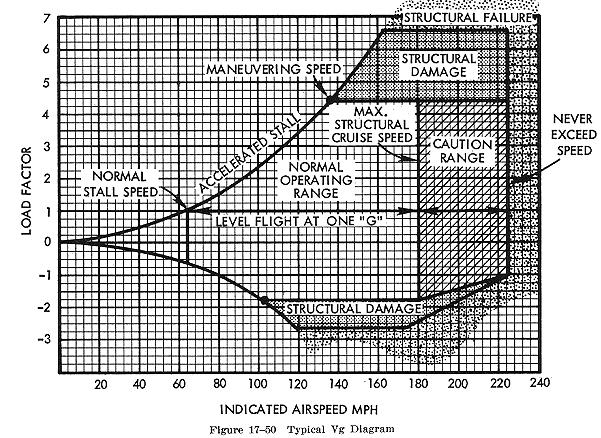

The flight operating strength of an airplane is presented on a graph whose horizontal scale {should be vertical scale -Ed.} is based on load factor (Fig. 17-19) {should be Fig. 17-50 - Ed.}. The diagram is called a V/g diagram - velocity versus "g" loads or load factor. Each airplane has its own V/g diagram which is valid at a certain weight and altitude.

The lines of maximum lift capability (curved lines) are the first items of importance on the V/g diagram. The subject airplane in the illustration is capable of developing no more than one positive "g" at 62 mph, the wing level stall speed of the airplane. Since the maximum load factor varies with the square of the airspeed, the maximum positive lift capability of this airplane is 2 "g" at 92 mph, 3 "g" at 112 mph, 4.4 "g" at 137 mph etc. Any load factor above this line is unavailable aerodynamically; i.e., the subject airplane cannot fly above the line of maximum lift capability (it will stall). Essentially the same situation exists for negative lift flight with the exception that the speed necessary to produce a given negative load factor is higher than that to produce the same positive load factor.
If the subject airplane is flown at a positive load factor greater than the positive limit load factor of 4.4, structural damage will be possible. When the airplane is operated in this region, objectionable permanent deformation of the primary structure may take place and a high rate of fatigue damage is incurred. Operation above the limit load factor must be avoided in normal operation.
There are two other points of importance on the V/g diagram. Point A is the intersection of the positive limit load factor and the line of maximum positive lift capability. The airspeed at this point is the minimum airspeed at which the limit load can be developed aerodynamically. Any airspeed greater than point A provides a positive lift capability sufficient to damage the airplane; any airspeed less than point A does NOT provide positive lift capability sufficient to cause damage from excessive flight loads. The usual term given to the speed at point A is the "maneuvering speed," since consideration of subsonic aerodynamics would predict minimum usable turn radius to occur at this condition. The maneuver speed is a valuable reference point since an airplane operating below this point cannot produce a damaging positive flight load. Any combination of maneuver and gust cannot create damage due to excess airload when the airplane is below the maneuver speed.
Point B is the intersection of the negative limit load factor and line of maximum negative lift capability. Any airspeed greater than point B provides a negative lift capability sufficient to damage the airplane; any airspeed less than point B does not provide negative lift capability sufficient to damage the airplane from excessive flight loads.
The limit airspeed (or redline speed) is a design reference
point for the airplane - the subject airplane is limited to 225 mph. If
flight is attempted beyond the limit airspeed structural damage or structural
failure may result from a variety of phenomena.
Thus, the airplane in flight is limited to a regime of
airspeeds and g's which do not exceed the limit (or redline) speed, do
not exceed the limit load factor, and cannot exceed the maximum lift capability.
The airplane must be operated within this "envelope" to prevent structural
damage and ensure that the anticipated service lift of the airplane is
obtained. The pilot must appreciate the V/g diagram as describing the allowable
combination of airspeeds and load factors for safe operation. Any maneuver,
gust, or gust plus maneuver outside the structural envelope can cause structural
damage and effectively shorten the service life of the airplane.